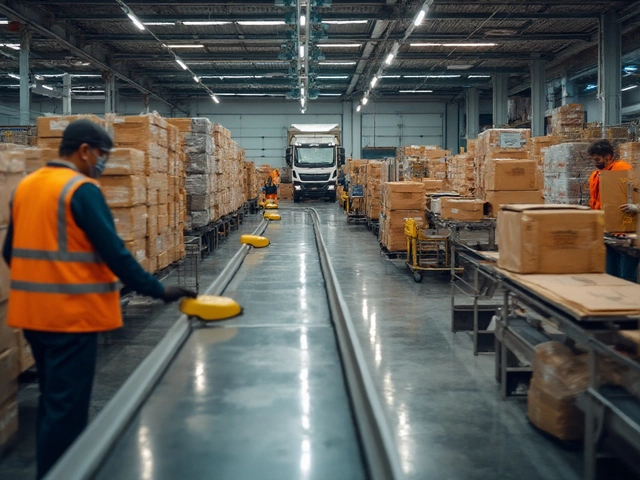In the fast-paced world of parcel delivery, one might wonder how couriers juggle the endless stream of packages and still manage their finances. Is a courier's pay as straightforward as it seems, or does it resemble a puzzle of intricate pieces? The common belief that couriers earn money per parcel might not be the entire story. Delving deeper, their income weave is spun from various threads—company policies, work contracts, and the number of parcels catered on any given day.
Understanding how these factors interplay not only sheds light on the couriers’ professional landscape but also offers a perspective on the behind-the-scenes hustle of getting your package delivered on time. For those curious about the life of couriers or perhaps contemplating joining their ranks, this exploration provides valuable insights and, for couriers themselves, practical tips to enhance their earnings in an industry that never sleeps.
- Exploring the Courier Payment Structure
- Factors Influencing Courier Earnings
- Delivery Volume and Its Impact
- Tips for Couriers to Maximize Earnings
Exploring the Courier Payment Structure
The remuneration model for couriers can be as diverse as the parcels they deliver. On the surface, it might appear that they're paid purely by the number of deliveries they complete, but in reality, several systems exist that define their actual earnings.
A predominant method involves payment per parcel, yet this is often part of a more intricate compensation package. In some models, couriers receive a base salary, with the potential to earn additional fees per delivery, especially during peak times or for locations that are harder to reach. Companies might also offer performance bonuses, incentivizing couriers to exceed delivery targets or maintain high customer satisfaction ratings, adding complexity to their earning potential.
Hourly versus Per-Parcel Schemes
While many couriers operate as independent contractors paid per parcel, larger courier and logistics companies often employ full-time couriers on an hourly wage. This shift aims to offer consistent income and benefits, appealing to those who prefer stability over the volatility of the gig economy. For smaller parcel delivery companies, a hybrid model might be in place where they blend hourly wages with variable pay based on delivery numbers.
Contract Terms and Variability
When examining courier earnings, it's crucial to consider the contractual terms involved. Independent couriers often have agreements that let them set their schedules, which impacts how many parcels they can feasibly deliver in a day. In contrast, employed couriers might have fixed schedules but guaranteed earnings regardless of the day's delivery volume.
| Payment Model | Description |
|---|---|
| Per Parcel | Earn based on number of deliveries, common for independent contractors. |
| Hourly Wage | Receive a consistent paycheck, often accompanied by benefits, typical in large companies. |
| Hybrid Model | Combination of base pay per hour and additional per parcel incentives, used in smaller or regional companies. |
Understanding these varied payment structures helps demystify the financial workings of the courier industry. Such knowledge can guide those considering a courier career while granting customers a newfound appreciation for the complex dance couriers perform to ensure packages reliably reach their intended destinations.
Factors Influencing Courier Earnings
Delving into the mysterious realm of how couriers are compensated, one finds a labyrinth of influences that dictate their financial outcomes. While at first glance it might appear straightforward, the reality is that a tapestry of elements intricately weaves together to determine their earnings.
Company Policies
At the heart of any parcel delivery job lies the policies outlined by the employer. Different courier companies adopt varied remuneration models. Some opt for a flat rate system where couriers receive a base pay regardless of the number of deliveries. Others might offer a commission-based structure that pays per parcel delivered, incentivizing higher delivery volumes.
Prominent players in the industry, such as DHL or FedEx, often provide a hybrid system combining a stable monthly wage with performance-based bonuses. This system ensures a degree of financial stability while rewarding efficiency and higher output.
Contract Type
The nature of the contract signed by couriers significantly impacts their potential earnings. Permanent employees typically benefit from fixed salaries and perks like healthcare and retirement plans. However, freelance couriers, who might be independent contractors, often face a different reality with earnings that fluctuate based on delivery opportunities and their ability to secure work consistently.
A keen-eyed observer would note that nearly 30% of couriers in certain markets work as freelancers, navigating the gig economy with flexibility and agility.
Delivery Volume and Efficiency
The volume of deliveries a courier completes and their efficiency can make or break their paycheck. Urban couriers might deliver up to 100 parcels a day thanks to densely populated zones, while rural couriers cover larger distances with fewer deliveries.
Impact of Technology
Technology serves as both ally and adversary. Smart routing apps and real-time tracking systems enable couriers to optimize their routes, potentially increasing the number of parcels they can deliver per day. However, these tools necessitate staying updated with constantly evolving software, adding a layer of required expertise.
| Aspect | Explanation |
|---|---|
| Urban vs Rural | Urban couriers manage higher parcels but face traffic delays; rural covers longer distances with fewer deliveries. |
| Technological Know-How | Mastery of routing apps can significantly enhance delivery efficiency. |
Seasonal Fluctuations
Certain times of the year, such as the festive season or sales events like Black Friday, can lead to a surge in deliveries. During these periods, couriers stand to earn substantially more due to increased demand. However, off-peak times may bring leaner earnings, especially for those reliant on volume-based pay.
Understanding these multifaceted elements provides a clearer view of a courier's financial landscape—one that requires adaptability, skill, and occasionally, a little bit of luck.

Delivery Volume and Its Impact
In the realm of courier services, the volume of deliveries plays a pivotal role in defining the everyday life of couriers. For those wondering whether couriers indeed get paid per parcel, the sheer number of deliveries handled can directly steer their income trajectory. While some courier companies do remunerate per parcel delivery, others adopt a salaried or hourly wage approach, often with incentives tied to high delivery volumes.
High Volume Equals Higher Earnings?
The direct correlation between delivery volume and a courier’s earnings is not always as linear as it seems. In some business models, higher delivery volumes are incentivized through bonuses. These might range from a small per-parcel fee to significant payouts when particular volume thresholds are crossed. The logic here is simple: the more the courier delivers, the more they earn.
Yet, one cannot ignore the other side of the coin—logistical constraints. High volumes can impact the quality of service, potentially leading to delivery errors or customer dissatisfaction. Thus, companies must carefully balance the drive for high volumes with maintaining service excellence.
Challenges of Managing High Delivery Volume
With increased delivery volume comes inevitable challenges. Couriers might face tight schedules, relying heavily on strategic route planning and time management skills. The physical demands can also increase substantially, affecting not only their earnings but also their health and well-being over time.
Efficient Route Planning
Typically, couriers will use technology-enhanced route planners to optimize their travel paths. These tools allow them to handle more deliveries efficiently, thereby increasing their earnings potential per hour spent on the road.
| Route Optimization Tool | Effectiveness | Cost to Courier |
|---|---|---|
| Google Maps | Medium | Free |
| Route4Me | High | Subscription-based |
As this table shows, different tools can impact how efficiently couriers handle delivery routes. For some, investing in advanced software can pay dividends in time and cost savings.
Balancing Workload and Earnings
In essence, while high delivery volumes hold the allure of increased earnings, they also demand significant effort and can carry their own set of hurdles. Couriers who succeed in managing these effectively not only maximize their courier earnings but also ensure sustainable practices are in place to counter potential burnout or negative customer experiences. Adopting the right strategies with the help of technology and smart planning can indeed turn this delivery volume into a lucrative advantage.
Tips for Couriers to Maximize Earnings
For anyone navigating the bustling world of parcel delivery, maximizing earnings is a crucial aspect of success. Here are some practical strategies that can help couriers enhance their take-home pay in an industry driven by efficiency and speed.
1. Organize Your Route
One of the most effective ways to improve efficiency is by optimizing your delivery route. Utilizing apps like Google Maps or Waze can save time and fuel, allowing you to complete more deliveries in less time. Some companies might even offer their proprietary route optimization tools—make sure to take full advantage of these resources.
2. Focus on High-Volume Areas
Certain areas tend to have higher delivery volumes, offering couriers ample opportunities to increase their earnings. Focus on densely populated localities or business districts, where deliveries can be clustered, reducing travel time between parcels. Knowing your city well can play a significant role in identifying these lucrative areas.
3. Maintain Your Vehicle
Your vehicle is your lifeline, and keeping it in top condition ensures that you can reliably complete your deliveries. Regular maintenance prevents unexpected breakdowns, helping you avoid downtime. A well-maintained vehicle also tends to be more fuel-efficient, directly impacting your bottom line.
4. Develop Customer Relationships
Building good rapport with customers and businesses can potentially lead to more work through referrals or repeat deliveries. This is especially true if you are an independent courier. Positive interactions can also result in tips, providing a nice supplement to your standard per parcel earnings.
5. Leverage Technology
In today's digital age, technology can be a courier's best friend. Mobile apps for tracking deliveries, managing time, and even predicting traffic can enhance your productivity. Additionally, staying updated with the latest trends and tools in the courier industry can open up new opportunities for revenue streams.
| Strategy | Potential Increase in Earnings |
|---|---|
| Route Optimization | 15-20% |
| High-Volume Area Focus | 10-15% |
| Vehicle Maintenance | 5-10% |
| Customer Relationships | 5-20% |
Ultimately, the approach each courier takes will vary based on personal circumstances and the nature of their contract—be it full-time, part-time, or independent. However, incorporating these tips into a daily routine not only maximizes your courier earnings but also helps provide a more satisfying and sustainable career path in parcel delivery.





